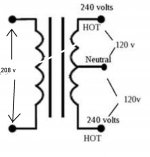measured on 208V shore power coming out of the transformers.
There was mention of an isolation transformer previously. Can you provide details for this?
The transformer specified is what is known as an 'autotransformer'. This means that there is a single set of coils electrically connected to both the primary and secondary sides. An autotransformer has significant benefit that much less copper and steel are used for the same output capacity, especially if small voltage changes are involved. A transformer that takes 208V (L-L) up to 240V (L-L only) is a perfect application for an autotransformer.
The downside of the autotransformer is that there is no isolation from input circuit to output circuit. If the input circuit is grounded, then the output circuit is also grounded, but via the input circuit. Grounding of the output circuit can cause a short circuit, or might change the characteristics of the system.
@synchro described this problem back in post #7; while the transformers specified in the schematic will do a great job of converting 208V to 240V, the 'neutral' that they derive is going to be at an elevated 60V relative to the (usually grounded) neutral of the 208V source. On top of what he described, because the particular transformer selected does a bad job of deriving a neutral, when the 'secondary' neutral point was grounded, what ended up happening was that the output L-N voltage got boosted to 136V. (
@mechwizard1 noted this voltage issue in post #32, when the generator G-N jumper was in place. Without the G-N jumper, each transformer half was fed with half of the supplied 208V, boosting 104V to 120V. With the G-N jumper in place each transformer half was fed with 120V, and boosted it to 136V.)
An isolation transformer is simply a common transformer with separate primary and secondary coils. There is no electrical connection between the two, just the magnetic coupling that transfers power. The grounding of the secondary of such a transformer is completely independent of the supply grounding.
An example of such a transformer is
https://www.hubbell.com/acmeelectri...-Phase-120208240277---120240V-15kVA/p/1655263
This would take the 208V input and convert it into a 120/240V single phase output. The secondary would need to be appropriately grounded, meaning that the neutral of the secondary would be electrically connected to ground at some point, possibly at the transfer switch. Secondary grounding of an isolation transformer will not have the effect of boosting the output voltage.
I've not done a load calculation, so don't know if the example transformer is large enough or too large; I just wanted to show you an example of such a transformer. I believe that Larson has similar.
-Jon


